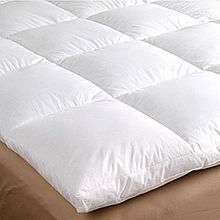Featherbed

A featherbed is a type of bedding traditionally used on top of mattresses to help make them softer. They can be made either with feathers, down, or a combination of both materials. Such a bed should be frequently shaken out or fluffed, to keep the feathers evenly distributed.
Featherbeds were only for the rich in the 14th century, but by the 19th century they were a comfort that ordinary people could aspire to - especially if they kept a few geese. The beds, also called feather ticks or feather mattresses, were valuable possessions. People made wills promising them to the next generation; emigrants, travelling to the New World from Europe, packed up bulky featherbeds and took them on the voyage.
Feathers for a featherbed could be saved from geese or ducks being prepared for cooking. In England servant-girls were often allowed to keep feathers from poultry they'd plucked, and could save them to make a featherbed or pillows for their future married life. Live birds might have their soft downy breast feathers harvested three or four times a year, as described in an account from 20th century Missouri. Some poultry feathers were undesirable for mattress-making, especially chicken feathers. The best featherbeds were filled with a high proportion of down; larger feathers needed to have their quills clipped.
Lengthy preparation and good aftercare were essential. Before use, all feathers and down had to be aired outdoors in sun and breeze or stoved indoors in a warm dry space; this would reduce smell and eliminate moisture. Even so, there could be what Harriet Beecher Stowe called "the strong odour of a new feather-bed and pillows". The big London furniture store Heal & Son offered to clean and "purify" old beds with new steam machinery. They said this would remove the "offensive properties of the quill" and also the "unpleasant smell of the stove" which affected all feathers prepared the usual way. They claimed the process would expand and bulk up feathers to make the bed much softer.
Feather ticks were not often used alone, but were laid over a firmer, non-feather mattress, where a white feather mattress is spread on top of the striped under-mattress. Because the mattresses were just bags with no inner structure, they needed shaking and re-shaping every morning. Learning to plump and smooth the bed well was one of the arts of housekeeping.
Featherbeds were criticised by a few 19th century writers who felt they were unhealthy: too warm, too soft, and too self-indulgent. Florence Nightingale said "Never use a feather bed, either for sick or well". Some people chose to put their feather tick under a straw, horsehair or flock mattress in order to have a firmer or cooler bed.[1]
References
- ↑ http://www.oldandinteresting.com/history-feather-beds.aspx History of Feather Beds